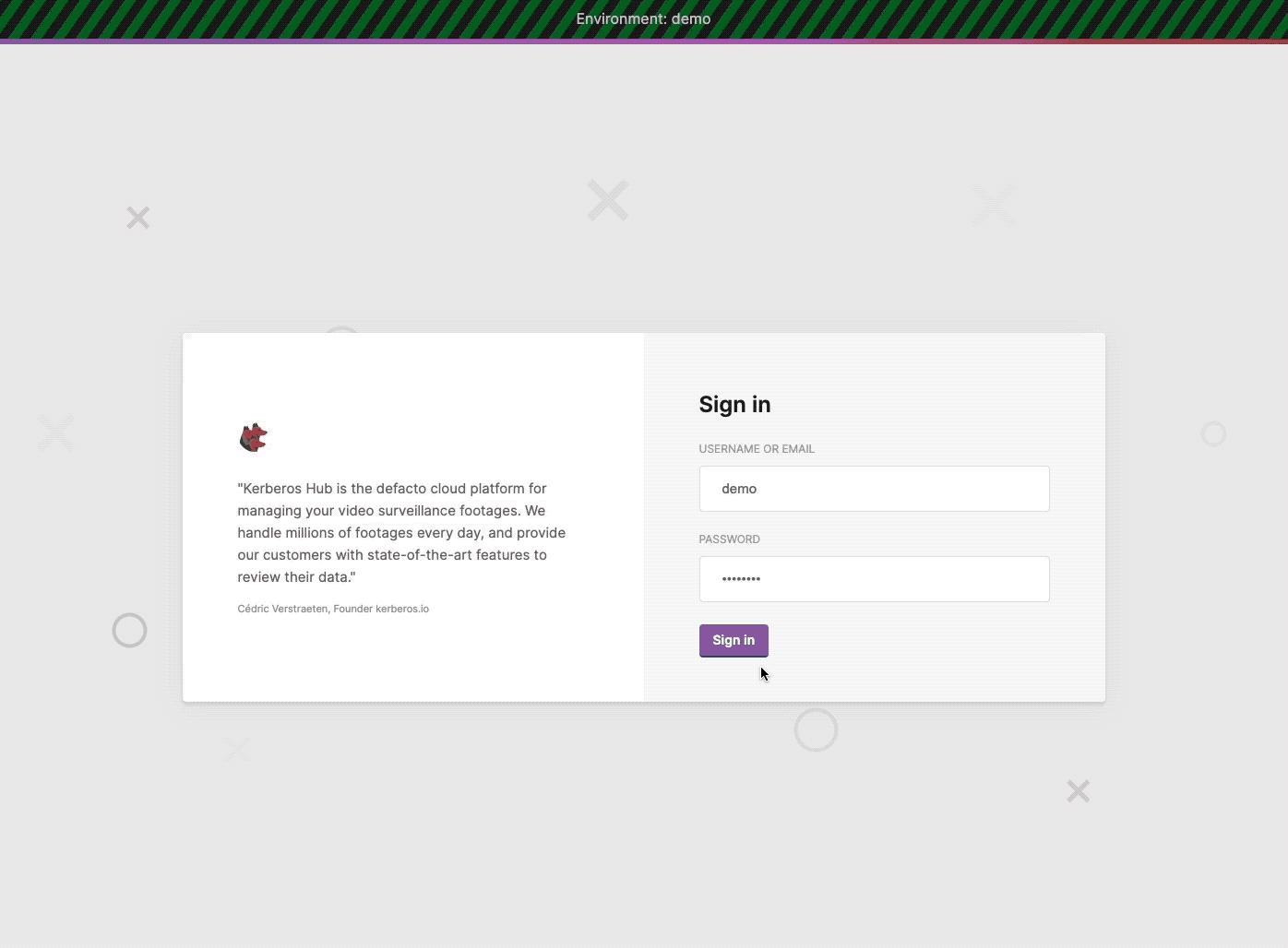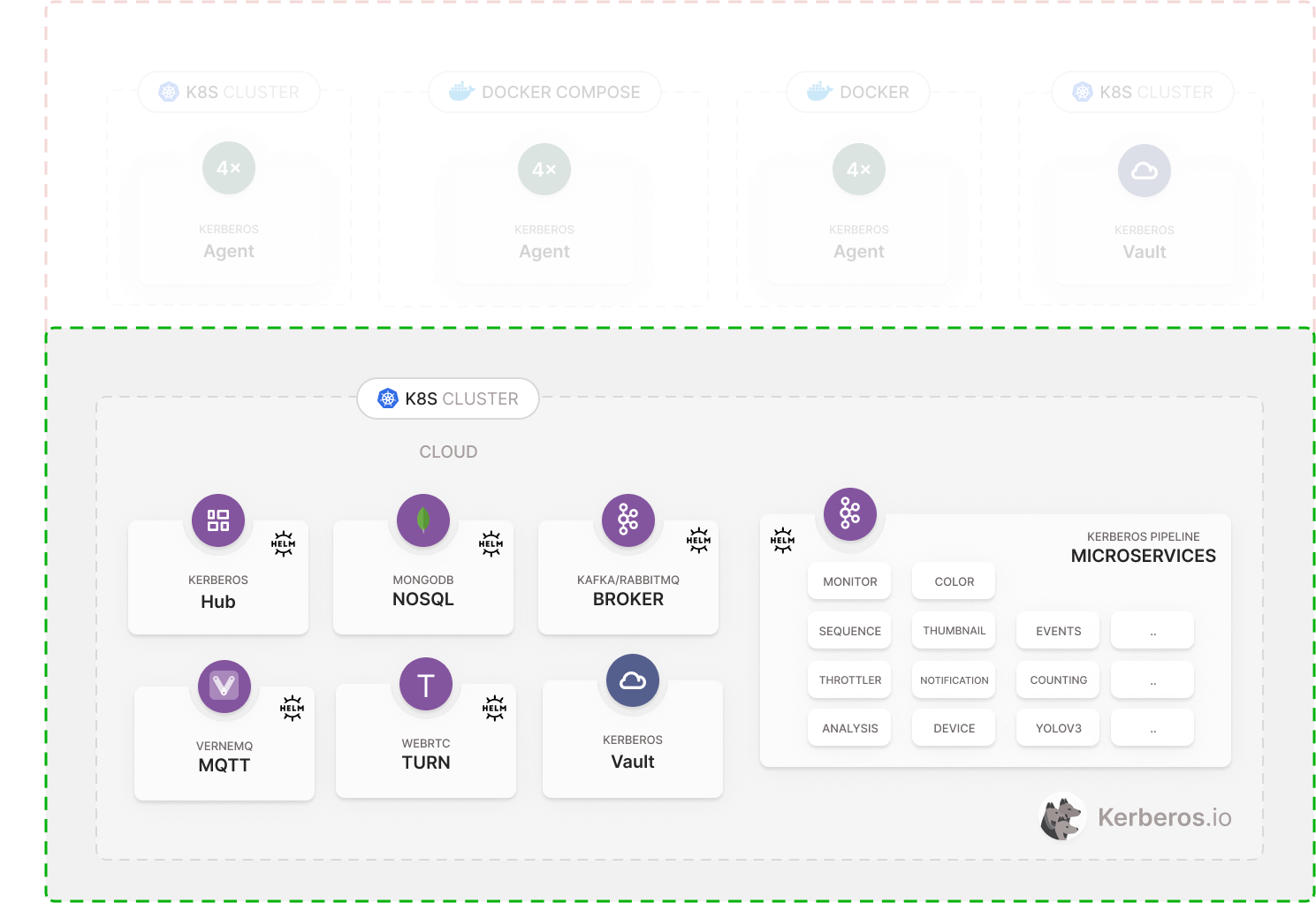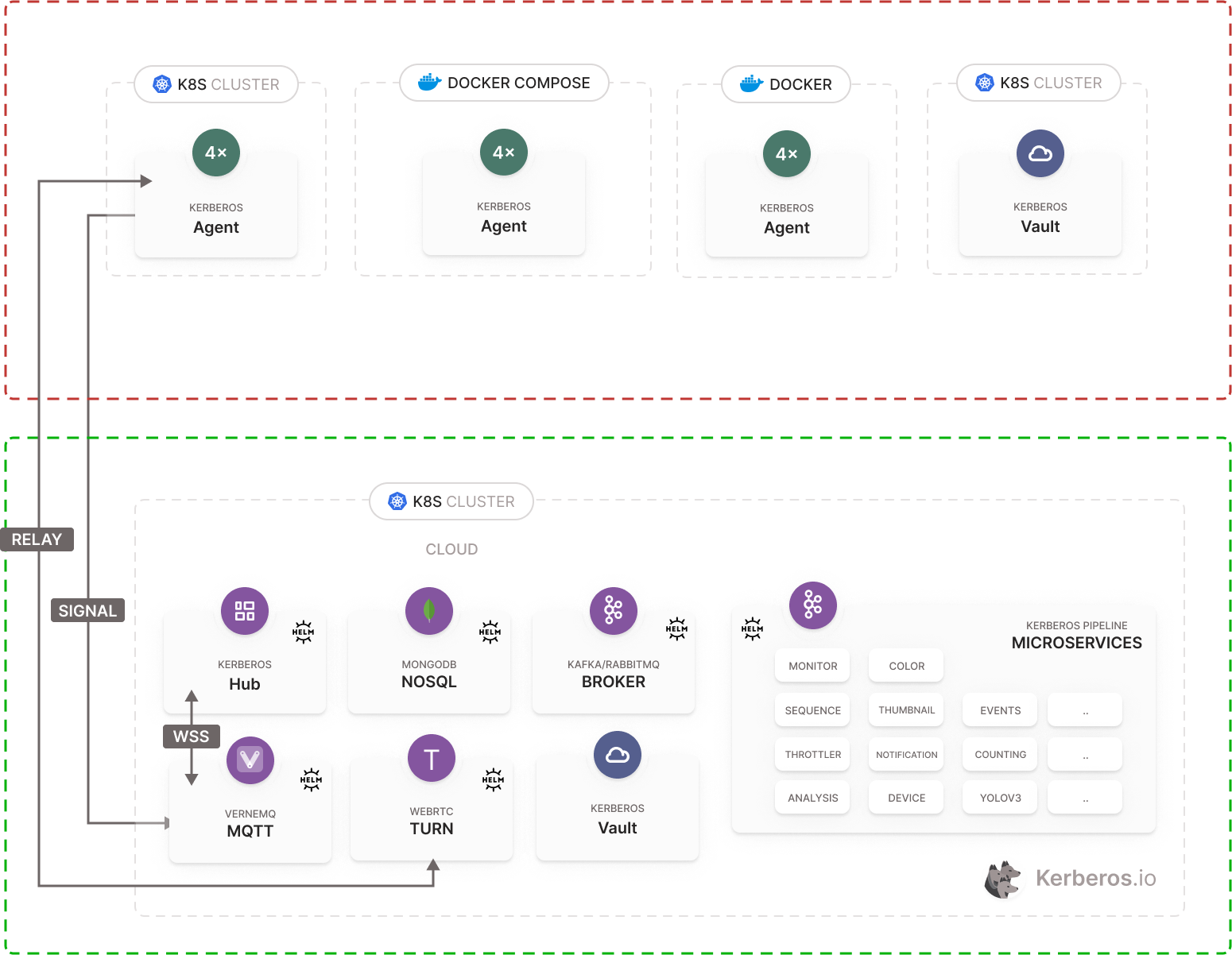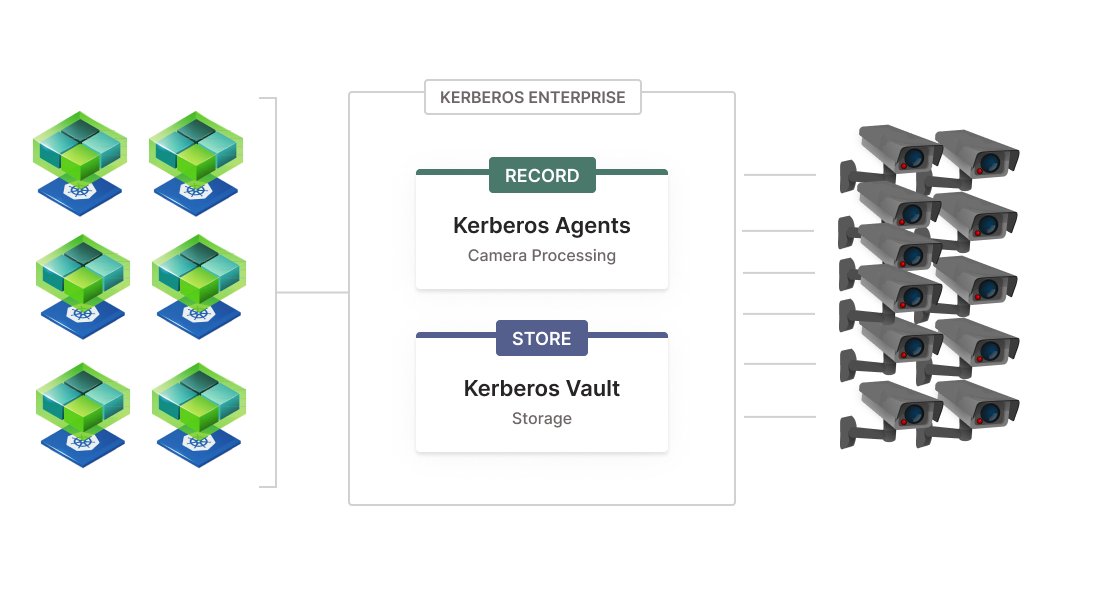Kerberos Hub is the single pane of glass for your Kerberos Agents. It comes with a best of breed open source technology stack, modular and scale first mindset, and allows you to build and maintain an everless growing video surveillance and video analytics landscape.
To use Kerberos Hub a license is required. This license will grant access the Kerberos Hub API, and allow to connect a number of cameras and Kerberos Vaults. Request a license at support@kerberos.io.
The Kerberos Hub service has several dependencies, as described below. Different components needs to be installed and are leveraged by Kerberos Hub to store data (MongoDB), bi-directional communication (MQTT/Vernemq), etc. Each of these services are installed through the concept of Helm charts. Once all dependencies are installed you will see that Kerberos Hub itself is also installed through the Kerberos Hub helm chart.
This repo describes how to install Kerberos Hub inside your own Kubernetes cluster (or K3S cluster) using a Helm chart.
A couple of dependencies need to be installed first:
- A message broker (RabbitMQ, Kafka or others)
- an event broker (Vernemq)
- a database (MongoDB),
- and a TURN server (Pion)
Next to that one can use an Nginx ingress controller or Traefik for orchestrating the ingresses, however this is all up to you. Once all dependencies are installed, the appropriate values should be updated in the Kerberos Hub values.yaml file.
We do manage certificates through cert-manager and letsencrypt, and rely on HTTP01 and DNS01 resolvers. So you might need to change that for your custom scenarion (e.g. on premise deployment).
As shown below you will find the architecture of what we are going to install (the green rectangle).
The Kerberos Hub installation makes use a couple of other charts which are shipped within their on Helm repos. Therefore, we will add those repos to our Kubernetes cluster.
helm repo add bitnami https://charts.bitnami.com/bitnami
helm repo add jetstack https://charts.jetstack.io
helm repo add traefik https://helm.traefik.io/traefik
helm repo add vernemq https://vernemq.github.io/docker-vernemq
helm repo add kerberos https://charts.kerberos.io
helm repo update
We rely on cert-manager and letsencrypt for generating all the certificates we'll need for the Kerberos Hub web interface, Kerberos Hub api and the Vernemq broker (WSS/TLS).
As a best practice we will install all the dependencies in their own namespace. Let's start by creating a separate namespace for cert-manager.
kubectl create namespace cert-manager
Install the cert-manager helm chart into that namespace.
helm install cert-manager jetstack/cert-manager --namespace cert-manager --set installCRDs=true
If you already have the CRDs install you could get rid of --set installCRDs=true.
Next we will install a cluster issuer that will make the HTTP01 challenges, this is needed for resolving the certificates of both Kerberos Hub web interface and api.
kubectl apply -f cert-manager/cluster-issuer.yaml
A great way to manage your cluster through a UI is Rancher. This is totally up to you, but we love to use it a Kerberos.io
helm repo add rancher-latest https://releases.rancher.com/server-charts/latest
helm repo update
kubectl create namespace cattle-system
helm install rancher rancher-latest/rancher \
--namespace cattle-system \
--set hostname=rancher.kerberos.xxx \
--set ingress.tls.source=letsEncrypt \
--set letsEncrypt.email=xxx@email.com \
--set 'extraEnv[0].name=CATTLE_TLS_MIN_VERSION' \
--set 'extraEnv[0].value=1.2'
To integrate, scale and make Kerberos Hub more resilient the Kerberos Hub pipeline is using a message broker (or queue) to provide a resilient message flow. The message broker integrates the different micro services you'll find in Kerberos Hub, and allow you to scale specific services independently. As of now we suppor two main messages brokers: RabbitMQ and Kafka. Depending on your current solution landscape and/or skills you might prefer one over the other.
RabbitMQ is the preferred message broker, as it's easy to setup, scale and comes with high availability out of the box. RabbitMQ will distribute messages to the different consumer (microservices).
As a best practice let's create another namespace.
kubectl create namespace rabbitmq
Before installing the RabbitMQ helm chart, make sure to have a look at the rabbitmq/values.yaml file. This includes different variables such as username, password, replicaCount and more. Change those settings for your own preference or usecase.
helm install rabbitmq bitnami/rabbitmq -n rabbitmq -f rabbitmq/values.yaml
You might need to add a few CRD's. If you see following error, unable to recognize "": no matches for kind "ServiceMonitor" in version "monitoring.coreos.com/v1.
kubectl create -f https://raw.githubusercontent.com/prometheus-operator/prometheus-operator/master/bundle.yaml
Kafka is used for the Kerberos Pipeline, this is the place where microservices are executed in parallel and/or sequentially. These microservices will receive events from a Kafka topic and then process the recording, and it's metadata. Results are injected back into Kafka and passed on to the following microservices. Microservices are independently horizontal scalable through replicas, this means that you can distribute your workload across your nodes if a specific microservice requires that.
As a best practice let's create another namespace.
kubectl create namespace kafka
Before installing the Kafka helm chart, go and have a look in the kafka/values.yaml file. You should update the clientUsers and clientPasswords. Have a look at the zookeeper credentials as well and update accordingly. Make sure to install version 18.4.4, as this values.yaml is matched for that specific helm release.
helm install kafka bitnami/kafka -f ./kafka/values.yaml -n kafka --version 20.0.2
Next to a message broker, we are using an event broker (MQTT) for bidirectional communication in the Kerberos Hub ecosystem.
This Vernemq broker, which is horizontal scalable, allows communicating with Kerberos agents at the edge (or wherever they live) and Kerberos Vault to forward recordings from the edge into the cloud.
We'll create a namespace for our event broker Vernemq.
kubectl create namespace vernemq
Create a certificate, so we can handle TLS/WSS. (this needs a DNS challenge)
kubectl apply -f vernemq/vernemq-secret.yaml --namespace cert-manager
kubectl apply -f vernemq/vernemq-issuer.yaml --namespace vernemq
kubectl apply -f vernemq/vernemq-certificate.yaml --namespace vernemq
By default, a username and password is set for the Vernemq broker. You can find these in the vernemq/values.yaml file as shown below.
...
- name: DOCKER_VERNEMQ_USER_YOURUSERNAME
value: "yourpassword"
...
Please note that the username is defined in capitals YOURUSERNAME, but will result as yourusername. So anything written in capitals, will be lowercase.
Go a head and install the Vernemq chart with the relevant configuration options.
helm install vernemq vernemq/vernemq -f vernemq/values.yaml --namespace vernemq
Within Kerberos Hub data is stored/required for users, recordings, sites, groups and many other entities. As for now the entire Kerberos.io technology stack is relying on MongoDB.
A MongoDB instance is used for data persistence. Data might come from the Kerberos Pipeline or user interaction on the Kerberos Hub frontend.
We will create a namespace for our Mongodb deployment as well.
kubectl create namespace mongodb
Create a persistent volume, this is where the data will be stored on disk.
kubectl apply -f ./mongodb/fast.yaml
Before installing the mongodb helm chart, go and have a look in the mongodb/values.yaml file. You should update the root password to a custom secure value.
helm install mongodb bitnami/mongodb --values ./mongodb/values.yaml -n mongodb
Within Kerberos Hub we allow streaming live from the edge to the cloud without port-forwarding. To make this work we are using a technology called WebRTC that leverages a TURN/STUN server.
To run a TURN/STUN server please have a look at following repository, this will deploy a Docker container on a specific host that will act as a proxy for network traversal. The TURN/STUN server will make sure a connection from a Kerberos Agent to a Kerberos Hub viewer is established.
Ingresses are needed to expose the Kerberos Hub front-end and api to the internet or intranet. We prefer nginx ingress but if you would prefer Traefik, that is perfectly fine as well.
We'll use following helm chart ingress-nginx for setting up nginx in our cluster.
helm upgrade --install ingress-nginx ingress-nginx \
--repo https://kubernetes.github.io/ingress-nginx \
--namespace ingress-nginx --create-namespace
On AKS add following attribute, otherwise nginx will not be accessible through LoadBalancer. You will receive an not reachable error.
--set controller.service.externalTrafficPolicy=Local
helm install traefik traefik/traefik -f ./traefik/values-ssl.yaml
So once you hit this step, you should have installed a previous defined dependencies. Hopefully you didn't have too much pain with the certificates. Go to the Kerberos Hub helm chart repo when installing for the first time, there you'll find all the relevant information for configuring and creating.
If you already know what to do, grab the latest values.yaml at the Kerberos Hub Helm chart repo, and reference it from your helm install or helm upgrade command.
Install the Kerberos Hub chart in a specific namespace and take into the values.yaml file.
helm install hub kerberos/hub --values values.yaml -n kerberos-hub --create-namespace
Upgrade the Kerberos Hub chart
helm upgrade hub kerberos/hub --values values.yaml -n kerberos-hub
Uninstall the Kerberos Hub chart
helm uninstall hub -n kerberos-hub
The Hub Object Detector shows how to levarage machine learning into Kerberos Hub. By deploying this workload in a GPU enabled Kubernetes cluster (or standalone container) you can predict and track objects in your video feeds captured by your Kerberos Agents and stored in Kerberos Vault.
The object detector for Kerberos Hub is showing how you connect to a message broker (RabbitMQ, Kafka or others) and how you can consume and download recordings from Kerberos Vault. In the Kerberos Vault example directory we are showing a concrete example of how to do this.



